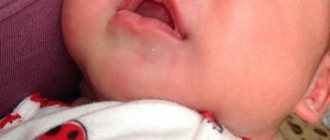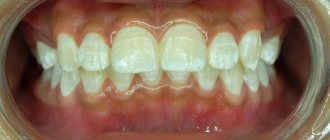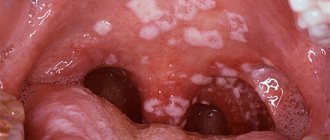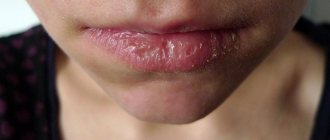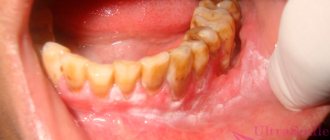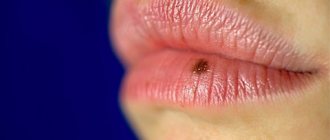Stomatitis of various etiologies
The oral mucosa becomes inflamed with stomatitis. Whitish spots are located on the inner sides of the cheeks, on the gum tissue. Without therapeutic measures, painful ulcers will quickly appear. Such children exhibit restless behavior, fever, loss of appetite, and disturbed sleep. The disease may be:
- Viral, when it occurs against the background of influenza, chickenpox, bronchitis and other diseases;
- Allergic, if the baby develops asthma, atopic dermatitis appears;
- Bacterial, when the little one picks up some kind of infection, for example, a fungal one;
Purulent cyst
A white spot on a child's gum may indicate the development of cysts. They look like beads. Occurs against the background of infection of the body. A formation with purulent contents is detected on x-ray. Most often, the disease is caused by bacteria that penetrate into the chewing organs or soft tissues. This happens with complicated caries. When the accumulated pus begins to come out, swelling appears. If you do not visit the pediatric dentist on time, the pus accumulates, then the abscess breaks out, and the little one develops a fistula. Don't ignore rashes in your child's mouth! Contact your doctor promptly!
Lipoma and leukoplakia
With leukoplakia, keratinization of the mucous membrane is noted. This process is influenced by the following stimuli:
- sharp edges of affected teeth;
- hanging uneven fillings;
- hot and spicy food;
- malocclusion;
- improperly fitted dentures;
- crowns made of various materials;
With this disease, whitish plaques may have clearly defined edges or blurred ones. There is no discomfort. The rash may be rough, cracks and ulcers may appear. The doctor will take a sample of this tissue to send for a biopsy. Often the formation turns out to be a harmless lipoma, that is, a wen. It requires medical supervision. It is important that its size does not increase.
Treatment of white spots on gums
The first thing parents need to do is visit a pediatrician. If necessary, the child will be referred to a dentist. Pediatric dentistry is a department where the factors that provoke the disease are determined. Depending on your age, the doctor will carry out therapeutic measures.
- In case of improper hygiene, the mother will receive professional recommendations.
- When pimples are a consequence of vitamin deficiency, the nutrition of the mother and child is adjusted. You should drink enough liquid.
- Congenital masticatory organs, if they are mobile, are removed.
- Pathological diseases are treated with modern methods.
- The toddler should be protected from anxiety and stress.
- Stomatitis is treated with antiseptics, for example, Miramistin. The drug is prescribed by a doctor.
- Candida fungus is eliminated with drugs such as Flucostat. The baby's mouth is treated with chlorhexidine.
- If there is a lack of calcium, the necessary minerals are prescribed.
You cannot puncture the blisters yourself. The gum tissue may be damaged. After all, with such a procedure, infection can easily occur.
White plaque on the gums (candidiasis) –
If your gums turn white, then you can suspect not only leukoplakia, but also oral candidiasis, in which a white coating may appear on the gums, tongue, mucous membranes of the cheeks and palate. Candidiasis is caused by fungi of the genus Candida. Most often it occurs against the background of reduced immunity, endocrine diseases, gastrointestinal diseases, anemia, hypovitaminosis, diabetes mellitus, HIV infection, chronic hepatitis, and smoking.
Long-term use of antibiotics and mouth rinses containing antibiotics and antiseptics can also lead to candidiasis. The presence of untreated carious teeth, inflammation of the gums, and poor oral hygiene also plays a big role in the occurrence of candidiasis.
White plaque on gums: photo
Prevention
To prevent the occurrence of pathology, preventive measures should be taken.
- The baby’s mouth should be cleaned after any meal and rinsed with boiled water.
- Mother and child should eat a balanced diet.
- It is necessary to protect the baby from kissing people who have sore gums, from traumatic games, and from chewing objects with sharp edges.
- Pacifiers, toys, bottles should be perfectly clean, like the hands of a toddler.
- See your dentist regularly for preventative checkups.
- The baby must use a separate towel and utensils.
Causes of stomatitis
Stomatitis on the tongue of a baby or in another part of the mucous membrane most often appears due to its fragile immunity, which had to deal with harmful environmental factors.
The causes of stomatitis in infants include the following:
- weakened immune system;
- fungal, viral or bacterial infection;
- disruption of the endocrine system;
- failure to comply with hygiene standards;
- microtrauma in the oral area;
- allergy;
- lack of vitamins and essential minerals.
Among the main causative agents of stomatitis in infants, the most common are:
- Candida fungus, popularly called thrush. It may appear in the womb, transmitted from the mother, or appear as a result of the influence of external stimuli;
- virus;
- drug or food allergies;
- genetic disposition.
Associated symptoms
The appearance of white spots on the lips may be accompanied by associated symptoms.
- The appearance of vesicles in herpes may be preceded by a sensation of itching, burning, tingling at the site of the virus attack.
- Aphthae (erosions) formed during bacterial or fungal stomatitis are very painful, especially when sucking, irritation with milk or food.
- Massive lesions of the mucous membrane by any type of pathogen can be accompanied by lethargy, refusal to eat, crying, and drooling.
In the absence of treatment or the addition of a secondary infection, the aphthae can undergo necrosis, to which the baby’s body reacts with symptoms of general intoxication: a rise in temperature to 39-40 ° C, anxiety, fever, and an unpleasant odor from the baby’s mouth.
Immunity-weakening diseases - the root causes of white spots on a child’s lips are manifested by organ or systemic symptoms: dyspeptic disorders, pain, bloating, frequent regurgitation, etc.
Why do white dots appear on the lips?
Most often, small white formations, felt like lumps on palpation, appear in women after the lip augmentation procedure. And the reasons for this may be:
- incorrect injection of filler - the depth of injection is not maintained;
- violation of lip care rules after the procedure;
- allergic reaction to anesthetic drugs;
- reduced general immunity.
But there are other reasons why white dots appear on the lips:
- Fordyce granules. They can occur in both men and women; doctors assess them as microcystic formations localized in the sebaceous glands. They are formed against the background of excessive production of sebaceous secretions, which leads to blockage of the glands. They also appear due to hormonal imbalance, physiological characteristics of the body, and narrowing of the sebaceous ducts.
- Dysbacteriosis. Accompanied by diarrhea or constipation, which reduces overall immunity and promotes the accumulation of toxic substances. This is due to an imbalance of healthy and pathogenic microflora in the intestines.
- Avitaminosis. Small white dots also form when there is a lack of minerals and vitamins in the body. It can be triggered by an unbalanced diet, a strict diet, pregnancy and breastfeeding.
- Zhiroviki. Whitish spots (lipomas) appear under the skin; they are defined as soft, mobile in consistency, and belong to the category of benign neoplasms. They can form due to hormonal imbalance, problems with the functionality of the gastrointestinal tract, and the use of low-quality cosmetics.
- Herpes. It usually occurs on the upper lip, appears as a bubble, is accompanied by itching and swelling, and sometimes causes mild pain. This is an infectious disease that occurs when the immune system is weakened.
White dots on a child’s lips can form:
- with candidal stomatitis – the fungus of the genus Candida is activated and begins to actively multiply;
- due to herpes virus - transmitted from mother to baby during the birth canal and during breastfeeding;
- with allergic stomatitis - the body’s reaction to internal irritants (food, milk formula, purees), usually localized on the inside of the lip.
When such formations appear, consultation with specialists is necessary.
How to treat white spots on the lips of a baby?
According to experts, the use of traditional medicine methods is not the best option to combat the problem. In order not to harm the child, it is not recommended to perform certain manipulations.
- Treat with a finger wrapped in gauze - this can further damage the delicate mucous membrane of the child’s lips and aggravate the problem. Use cotton swabs or pieces of sterile cotton wool.
- To treat aphthae, use a solution of brilliant green, tincture of iodine, or fucorcin - there is a high probability of causing a chemical burn.
- Use infusions of medicinal herbs - when treating or irrigating the mucous membrane, some of the solutions will inevitably be swallowed by the child, which can negatively affect digestion.
- Apply honey to the aphthae. Firstly, there is a high risk of the baby developing an allergic reaction. Secondly, sweets, being an excellent breeding ground for bacteria and fungi, stimulate their growth and development.
The basic principles of treating white spots in a child are maintaining good oral hygiene, gentle nutrition, and using medications as recommended by a pediatrician according to the child’s age.
- After each feeding, the oral cavity is washed using an irrigation bottle or bulb. To do this, the child is placed on his side, and the remaining milk or formula is removed with a gentle pressure of water.
- Then the top layer of plaque is removed from the spots and treated with a product prescribed by the pediatrician, taking into account the type of pathogen.
Local medications that are used to treat children for white spots include several groups aimed at combating a specific problem.
- If thrush is confirmed, pediatricians may prescribe to a newborn: Candida solution to treat white spots on the lips;
- Such babies are often advised to treat with a 2% aqueous solution of baking soda.
- Six-month-old children and older may additionally be prescribed Miramistin, Fluconazole, Diflucan.
- babies over one year old are treated with Lugol, Nystatin.
- Kamistad Baby, Kalgel - antiseptics containing painkillers;
- for children in the first year of life - Viferon gel, oxolinic ointment;
With widespread or severe stomatitis, local treatment alone may not be enough, and the pediatrician decides to additionally prescribe the drug for internal use.
- Antiviral, antibacterial, antifungal - depending on the type of pathogen.
- Allergic stomatitis requires antihistamines for newborns: Suprastin, Tavegil.
- Febrile fever is relieved with antipyretics, approved for use in children of the first year of life in the form of rectal suppositories, suspensions: Daleron, Ibuprofen, Nurofen, Calpol, etc.
- The vitamin and mineral balance of the body is replenished with age-appropriate treatment and prophylactic complexes.
Strictly adhere to the age-related dosages recommended by the doctor: the use of medications intended for older children can be harmful, and medications intended for younger children will not have the desired effect.
